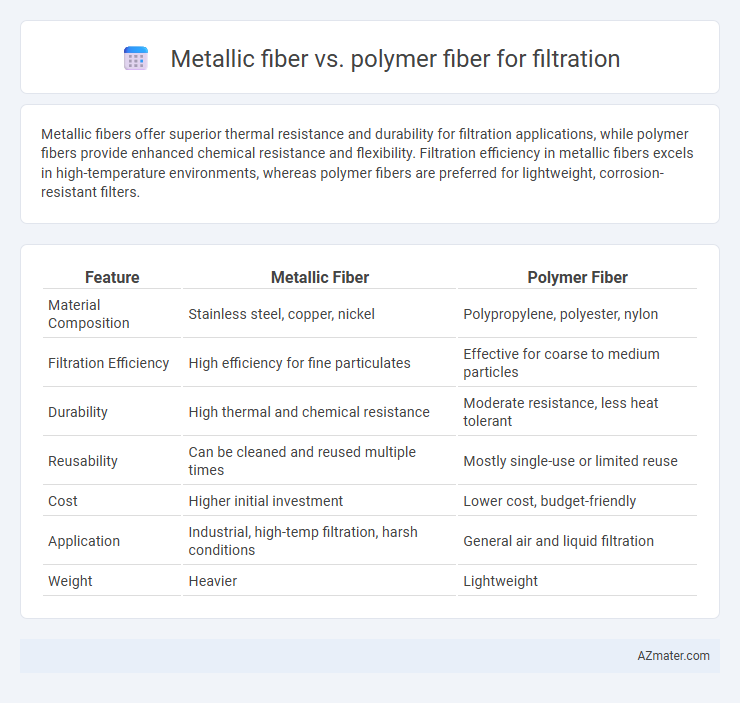Metallic fibers offer superior thermal resistance and durability for filtration applications, while polymer fibers provide enhanced chemical resistance and flexibility. Filtration efficiency in metallic fibers excels in high-temperature environments, whereas polymer fibers are preferred for lightweight, corrosion-resistant filters.
Table of Comparison
| Feature | Metallic Fiber | Polymer Fiber |
|---|---|---|
| Material Composition | Stainless steel, copper, nickel | Polypropylene, polyester, nylon |
| Filtration Efficiency | High efficiency for fine particulates | Effective for coarse to medium particles |
| Durability | High thermal and chemical resistance | Moderate resistance, less heat tolerant |
| Reusability | Can be cleaned and reused multiple times | Mostly single-use or limited reuse |
| Cost | Higher initial investment | Lower cost, budget-friendly |
| Application | Industrial, high-temp filtration, harsh conditions | General air and liquid filtration |
| Weight | Heavier | Lightweight |
Introduction to Filtration Fiber Types
Metallic fibers, such as stainless steel and copper, provide high durability, temperature resistance, and excellent mechanical strength, making them ideal for filtration in harsh environments and industrial applications. Polymer fibers, including polypropylene and polyester, offer lightweight, chemical resistance, and cost-effectiveness, which suit them for applications requiring corrosion resistance and flexibility. Selection between metallic and polymer fibers depends on filtration requirements like temperature tolerance, chemical exposure, and mechanical stress.
Overview of Metallic Fibers
Metallic fibers, often composed of stainless steel, copper, or aluminum, offer exceptional durability and high thermal resistance in filtration applications, making them suitable for harsh environments and high-temperature processes. Their rigid structure and corrosion resistance enhance filtration efficiency by maintaining consistent pore size and preventing fiber degradation over time. Compared to polymer fibers, metallic fibers provide superior mechanical strength and longevity, especially in industrial filtration systems requiring repeated cleaning and reuse.
Overview of Polymer Fibers
Polymer fibers, commonly used in filtration, offer excellent chemical resistance, flexibility, and lighter weight compared to metallic fibers, making them ideal for applications requiring corrosion resistance and low pressure drop. These fibers, typically made from materials like polypropylene, polyester, and nylon, provide high surface area and porosity, enhancing particulate capture efficiency. Polymer fiber filters are cost-effective, easy to manufacture, and widely utilized in air and liquid filtration systems across industrial and environmental sectors.
Filtration Efficiency: Metallic vs Polymer
Metallic fibers exhibit higher filtration efficiency due to their inherent rigidity and ability to maintain stable pore structures under high temperatures, enabling effective capture of fine particles and aerosols. Polymer fibers, while offering flexibility and cost-effectiveness, often struggle with lower thermal stability and potential deformation, which can reduce filtration performance especially in harsh environments. Advanced metallic fiber filters typically achieve filtration efficiencies exceeding 99.9% for submicron particles compared to polymer fiber filters, which generally perform optimally for larger particulate matter.
Durability and Longevity Comparison
Metallic fibers exhibit superior durability and longevity compared to polymer fibers in filtration applications due to their high resistance to heat, chemical corrosion, and mechanical wear. Polymer fibers, while lightweight and flexible, tend to degrade faster under harsh environmental conditions, leading to reduced lifespan and frequent replacement. The inherently robust structure of metallic fibers ensures sustained filtration efficiency and lower maintenance costs over time.
Chemical and Thermal Resistance
Metallic fibers exhibit superior thermal resistance, tolerating temperatures up to 1000degC or higher, making them ideal for high-temperature filtration applications such as molten metal or hot gas filtration. Polymer fibers, including polypropylene and polyester, offer excellent chemical resistance against acids and alkalis but degrade at temperatures typically above 150degC to 250degC, limiting their use in high-heat environments. The choice between metallic and polymer fibers depends on required chemical exposure and operating temperature, with metallic fibers preferred for extreme thermal conditions and polymer fibers favored for cost-effective chemical filtration under moderate heat.
Cost Analysis and Economic Considerations
Metallic fibers typically incur higher initial costs compared to polymer fibers due to raw material prices and energy-intensive manufacturing processes, though their durability and thermal resistance can reduce long-term replacement expenses. Polymer fibers, being more affordable and easier to produce, offer cost-effective solutions for large-scale, disposable filtration applications but may yield higher maintenance costs from lower chemical and temperature resistance. Economic considerations must weigh these upfront and operational costs against application-specific requirements like filter lifespan, maintenance frequency, and environmental conditions.
Environmental Impact and Sustainability
Metallic fibers in filtration offer durability and high-temperature resistance but have a higher environmental footprint due to energy-intensive extraction and lower biodegradability. Polymer fibers, especially those derived from bio-based or recycled sources, present a more sustainable option with easier recyclability and reduced carbon emissions during production. The choice between metallic and polymer fibers significantly influences the environmental impact, with polymers generally favored for eco-friendly filtration solutions.
Application Areas: Industry-Specific Suitability
Metallic fibers excel in high-temperature and corrosive environments, making them ideal for filtration in industries like petrochemical refining, power generation, and metal processing where durability and thermal resistance are critical. Polymer fibers offer chemical resistance and flexibility, suited for applications in water treatment, pharmaceuticals, and food processing where contaminant removal and lightweight media are prioritized. The specific industry demands dictate fiber choice, with metallic fibers preferred for harsh conditions and polymer fibers favored for cost-effective, versatile filtration solutions.
Choosing the Right Fiber for Filtration Needs
Metallic fibers offer superior heat resistance, durability, and chemical inertness, making them ideal for high-temperature filtration and aggressive chemical environments. Polymer fibers provide excellent flexibility, lightweight properties, and cost-effectiveness, suitable for general filtration applications requiring corrosion resistance and ease of fabrication. Selecting the appropriate fiber depends on the filtration environment, temperature tolerance, and chemical exposure, ensuring optimal performance and longevity.

Infographic: Metallic fiber vs Polymer fiber for Filtration
 azmater.com
azmater.com